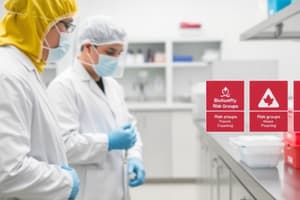Podcast
Questions and Answers
What are the four risk groups for pathogenic organisms and which group represents the highest risk?
What are the four risk groups for pathogenic organisms and which group represents the highest risk?
The four risk groups are Risk Group 1, 2, 3, and 4, with Risk Group 4 representing the highest risk.
What role does ABSA International play in laboratory safety?
What role does ABSA International play in laboratory safety?
ABSA International provides a free and searchable database for pathogenic organisms, aiding in laboratory and task-specific risk assessments.
How do Risk Group 3 pathogens typically affect their transmission?
How do Risk Group 3 pathogens typically affect their transmission?
Risk Group 3 pathogens usually cause serious disease but do not ordinarily spread from one infected individual to another.
What is the most common biological safety level that most clinical laboratories operate at?
What is the most common biological safety level that most clinical laboratories operate at?
What are 'Biological Safety Levels' and how are they designated?
What are 'Biological Safety Levels' and how are they designated?
What kind of work is commonly performed in BSL-3 laboratories?
What kind of work is commonly performed in BSL-3 laboratories?
Why is it important to know the risk groups of organisms in a laboratory?
Why is it important to know the risk groups of organisms in a laboratory?
What distinguishes Risk Group 2 pathogens from Risk Group 1 pathogens?
What distinguishes Risk Group 2 pathogens from Risk Group 1 pathogens?
What defines a pathogen that falls into Risk Group 4?
What defines a pathogen that falls into Risk Group 4?
List two factors that influence the pathogenicity of an organism.
List two factors that influence the pathogenicity of an organism.
What are two examples of preventive measures for managing high-risk pathogens?
What are two examples of preventive measures for managing high-risk pathogens?
What distinguishes a BSL-4 laboratory from lower biosafety levels?
What distinguishes a BSL-4 laboratory from lower biosafety levels?
Provide an example of a common specimen that can be safely handled in a BSL-2 laboratory.
Provide an example of a common specimen that can be safely handled in a BSL-2 laboratory.
What type of PPE is commonly required in a typical BSL-2 lab setting?
What type of PPE is commonly required in a typical BSL-2 lab setting?
When might enhanced precautions be necessary in a BSL-2 setting?
When might enhanced precautions be necessary in a BSL-2 setting?
Describe the role of PPE according to the CDC/NIOSH Hierarchy of Safety Controls.
Describe the role of PPE according to the CDC/NIOSH Hierarchy of Safety Controls.
What additional PPE may be worn in a 'BSL-2 enhanced' setting?
What additional PPE may be worn in a 'BSL-2 enhanced' setting?
Why might a lab director implement BSL-3 practices in a BSL-2 lab?
Why might a lab director implement BSL-3 practices in a BSL-2 lab?
Which types of work may require additional safety precautions in clinical labs?
Which types of work may require additional safety precautions in clinical labs?
What is the importance of classifying microorganisms by risk group?
What is the importance of classifying microorganisms by risk group?
Name one specific viral pathogen that requires special precautions when handled.
Name one specific viral pathogen that requires special precautions when handled.
How does local immunity affect the risk group classification of microorganisms?
How does local immunity affect the risk group classification of microorganisms?
What is the first step in the selection process of Personal Protective Equipment (PPE)?
What is the first step in the selection process of Personal Protective Equipment (PPE)?
List the mandatory minimum PPE requirements in a laboratory setting.
List the mandatory minimum PPE requirements in a laboratory setting.
When is eye protection required in the lab?
When is eye protection required in the lab?
What differentiates safety glasses from goggles in terms of protection?
What differentiates safety glasses from goggles in terms of protection?
Explain when face shields should be used in a laboratory.
Explain when face shields should be used in a laboratory.
How should prescription spectacles be treated in a laboratory environment?
How should prescription spectacles be treated in a laboratory environment?
What should a person do if their contact lens becomes contaminated with a hazardous chemical?
What should a person do if their contact lens becomes contaminated with a hazardous chemical?
What is a recommended method to prevent inhalation exposures in the lab?
What is a recommended method to prevent inhalation exposures in the lab?
What specific requirements does OSHA mandate for respirator use?
What specific requirements does OSHA mandate for respirator use?
Describe the main function of lab coats in a laboratory setting.
Describe the main function of lab coats in a laboratory setting.
What types of materials can lab coats be made from?
What types of materials can lab coats be made from?
Why are ordinary prescription glasses considered inadequate for lab protection?
Why are ordinary prescription glasses considered inadequate for lab protection?
What type of eye protection should be worn when working with pressurized glassware?
What type of eye protection should be worn when working with pressurized glassware?
What are the potential hazards that must be considered during hazard analysis?
What are the potential hazards that must be considered during hazard analysis?
What should be the first step in selecting a lab coat?
What should be the first step in selecting a lab coat?
How should you evaluate glove materials for handling hazardous chemicals?
How should you evaluate glove materials for handling hazardous chemicals?
What is the primary purpose of Personal Protective Equipment (PPE) in the lab?
What is the primary purpose of Personal Protective Equipment (PPE) in the lab?
What should be done if PPE cannot be properly cleaned or is damaged?
What should be done if PPE cannot be properly cleaned or is damaged?
What are bloodborne pathogens?
What are bloodborne pathogens?
What must an employer implement to control exposure to bloodborne pathogens?
What must an employer implement to control exposure to bloodborne pathogens?
What type of gloves should be used for handling chemicals of unknown toxicity?
What type of gloves should be used for handling chemicals of unknown toxicity?
What are the components of a GHS-Compliant Label?
What are the components of a GHS-Compliant Label?
Why should you never reuse disposable gloves?
Why should you never reuse disposable gloves?
In the case of a sharps-related injury, what should healthcare workers be aware of?
In the case of a sharps-related injury, what should healthcare workers be aware of?
What is the purpose of the Safety Data Sheet (SDS)?
What is the purpose of the Safety Data Sheet (SDS)?
What is flame resistance in relation to lab coat materials?
What is flame resistance in relation to lab coat materials?
What is the role of engineering controls in minimizing exposure to bloodborne pathogens?
What is the role of engineering controls in minimizing exposure to bloodborne pathogens?
What actions should be taken if PPE appears damaged?
What actions should be taken if PPE appears damaged?
How should PPE be stored?
How should PPE be stored?
Identify the three bloodborne pathogens of greatest concern to healthcare workers.
Identify the three bloodborne pathogens of greatest concern to healthcare workers.
What is the purpose of an Exposure Control Plan in relation to OSHA standards?
What is the purpose of an Exposure Control Plan in relation to OSHA standards?
List two examples of engineering controls that help protect healthcare workers.
List two examples of engineering controls that help protect healthcare workers.
Define what is meant by 'standard precautions' in healthcare settings.
Define what is meant by 'standard precautions' in healthcare settings.
What actions should be avoided when handling sharps to prevent injury?
What actions should be avoided when handling sharps to prevent injury?
What immediate action should be taken if an exposure incident occurs?
What immediate action should be taken if an exposure incident occurs?
Explain why proper disposal of sharps is important.
Explain why proper disposal of sharps is important.
What constitutes a parenteral exposure in healthcare settings?
What constitutes a parenteral exposure in healthcare settings?
Why are standard precautions applied to all body fluids except sweat?
Why are standard precautions applied to all body fluids except sweat?
What is a needle safety device and why is it necessary?
What is a needle safety device and why is it necessary?
Study Notes
Risk Groups and Biosafety Levels
- Pathogenic organisms are classified into four Risk Groups based on their potential for causing disease.
- Risk Group 1: Low individual and community risk, unlikely to cause disease.
- Risk Group 2: Moderate individual risk, low community risk, can cause disease but effective treatments are available.
- Risk Group 3: High individual risk, low community risk, can cause serious disease but usually doesn't spread easily.
- Risk Group 4: High individual and community risk, can cause serious disease and spread readily, effective treatments are usually unavailable.
Biosafety Levels
- Laboratories are classified based on their design, facilities, and practices into four Biosafety Levels (BSL) for handling organisms according to their risk group.
- BSL-1: Basic, for working with Risk Group 1 organisms, open bench work.
- BSL-2: Basic, for working with Risk Group 2 organisms, protective clothing, BSL-2 PPE.
- BSL-3: Containment, for working with Risk Group 3 organisms, controlled access, specialized clothing, BSC for all activities.
- BSL-4: Maximum containment, for working with Risk Group 4 organisms, airlock entry, special waste disposal, Class III BSC.
BSL-2 Lab Procedures
- Most clinical labs operate at BSL-2, handling routine specimens with standard precautions.
- Examples of common BSL-2 work:
- Stool cultures for enteric pathogens like Salmonella
- Urine cultures
- Blood chemistry testing
- Antibiotic sensitivity testing
- Streptococcus testing
- Examples of higher-risk BSL-2 specimens requiring additional precautions:
- Suspected Neisseria meningitidis testing
- Mycobacterium tuberculosis culture
- Respiratory and wound aspirate specimens for culture
- Subculture of positive blood cultures
- Known aerosol-generating procedures
BSL-2 Enhanced Precautions
- "BSL-3 practices" can be implemented in a BSL-2 lab when a risk assessment identifies higher risks.
- Additional PPE may include:
- Solid front gown
- Double gloves (nitrile)
- Disposable shoe covers
- Respiratory protection (N95, PAPR)
- PPE is the LAST line of defense, not a substitute for good lab practices or engineering controls.
PPE
- Eye protection: Safety glasses with side shields, goggles, face shields.
- Respiratory protection: Requires medical questionnaire, respirator fit test, and should be used only when engineering controls are insufficient.
- Lab coats: Provide protection from splashes and contamination, select based on hazard analysis.
- Gloves: Disposable latex, vinyl or nitrile gloves are usually suitable for BSL-2 labs, choose chemical-resistant gloves for specific hazards. Always inspect for damage and replace when contaminated.
Safety Data Sheet (SDS)
- Provides detailed information about chemicals, divided into 16 sections.
- Key sections for lab safety:
- Hazard identification: Details the risks associated with the chemical.
- First aid measures: Instructions for handling emergencies.
- Exposure controls/personal protection: Appropriate PPE and safety precautions.
Bloodborne Pathogens
- Infectious microorganisms found in human blood that can cause disease, including HBV, HCV, and HIV.
- OSHA's Bloodborne Pathogens Standard requires employers to implement an exposure control plan for workplaces with bloodborne pathogen risks.
- The plan includes:
- Engineering and work practice controls
- Personal protective equipment
- Employee training
- Medical surveillance
- Hepatitis B vaccinations.
Bloodborne Pathogens
- Healthcare workers are at risk of exposure to bloodborne pathogens, which are infectious organisms, usually viruses, that live in human blood and body fluids.
- The most concerning bloodborne pathogens for healthcare workers are Hepatitis B virus (HBV), Hepatitis C virus (HCV), and Human immunodeficiency virus (HIV).
- Healthcare workers are at greater risk for occupational Ebola Virus Disease (EVD) exposure than workers in most other professions.
OSHA Bloodborne Pathogens Standard
- The OSHA Bloodborne Pathogens Standard outlines requirements and recommendations for protecting healthcare workers from exposure to bloodborne pathogens.
- The standard includes requirements for an Exposure Control Plan, preventive measures like Hepatitis B vaccination and standard precautions, methods of control like engineering and work practice controls, personal protective equipment (PPE), housekeeping, and labeling, and procedures for dealing with exposure incidents.
Standard Precautions
- Standard Precautions are guidelines that state all blood and body fluids should be handled as if they are infectious and capable of transmitting disease.
- Standard precautions apply to blood, body fluids, secretions (except sweat), excretions, non-intact skin, and mucous membranes.
Methods of Control
- Engineering controls isolate the worker from the hazard by using devices such as self-sheathing needles, sharps disposal containers, disposable resuscitation bags, biological safety cabinets, hand washing facilities, and splash shields.
- Work practice controls specify how to perform a task safely and minimize exposure to infectious materials, including restrictions on smoking, eating, drinking, applying cosmetics or lip balm, handling contact lenses, and storing food and beverages in areas where blood or infectious materials are present.
Sharps Safety
- Sharps are any objects that can penetrate the skin, including needles, scalpels, and broken glass.
- Sharps should be handled and disposed of properly to prevent injury and potential infection.
- Most hospitals use needle/holder combinations with safety devices that cover the needle after use.
- Needleless systems are also available that use special adapters to avoid the use of needles.
Sharps Safety Summary
- Do:*
- Place all needles and other sharps in puncture-resistant sharps disposal containers as soon as possible after use.
- Use extreme caution or a safety device when removing a scalpel blade from its handle.
- Do Not:*
- Recap, bend, shear, or break needles.
- Remove needles from needle holders or disposable syringes.
- Fill sharps containers above the maximum fill line (no more than 3/4 full).
Exposure Incidents
- An exposure incident occurs when blood or another potentially infectious body fluid comes into direct contact with mucous membranes or non-intact skin.
- Parenteral exposure refers to exposure through needlesticks, cuts, or abrasions.
If an Exposure Occurs
- If an exposure occurs, wash the affected area immediately with soap and water.
- Contact your supervisor immediately for an evaluation and any necessary treatment.
- Confidentiality will be maintained, and blood testing will only be conducted with your consent.
Avoiding Exposure
- Using safe work practices will help prevent infection caused by exposure to bloodborne pathogens.
- Always think about how to perform tasks in a way that minimizes risk.
- Ensure that you are using the proper engineering controls and PPE for the task.
- If you are unsure how to accomplish a task safely, ask your supervisor.
Studying That Suits You
Use AI to generate personalized quizzes and flashcards to suit your learning preferences.
Description
Explore the classifications of pathogenic organisms into four Risk Groups based on their potential to cause disease, as well as the corresponding Biosafety Levels (BSL) established for laboratory settings. This quiz will test your understanding of how these levels relate to individual and community risks. Gain insight into best practices for safety in handling various biological agents.




